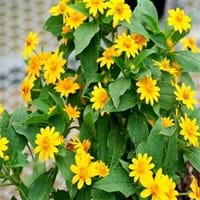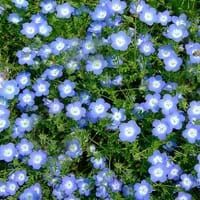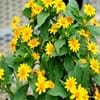Type
Flowering Plants
Flowering Plants, Herbs
Origin
Mexico, Central America
Western United States, Alaska, California
Types
MELAMPODIUM divaricatum 'Million Gold', MELAMPODIUM leucanthum, MELAMPODIUM divaricatum
Nemophila menziesii var. atomaria, Nemophila menziesii var. integrifolia, Nemophila menziesii var. menziesii
Number of Varieties
Not Available
Habitat
Loamy soils, Sandy areas, Well Drained
Chaparral, Grassland
USDA Hardiness Zone
6-9
3-9
AHS Heat Zone
12 - 6
Not Available
Sunset Zone
H1, H2, 1a, 1b, 2a, 2b, 3a, 3b, 4, 5, 6, 7, 8, 9, 10, 11, 12, 13, 14, 15, 16, 17, 18, 19, 20, 21, 22, 23, 24
A1, A2, A3, H1, H2, 1a, 1b, 2a, 2b, 3a, 3b, 4, 5, 6, 7, 8, 9, 10, 11, 12, 13, 14, 15, 16, 17, 18, 19, 20, 21, 22, 23, 24
Habit
Clump-Forming
Cushion/Mound-forming
Flower Color
Yellow, Gold
White, Blue, Light Blue, Sky Blue
Flower Color Modifier
Bicolor
Bicolor
Fruit Color
Sandy Brown
Not Available
Leaf Color in Spring
Green
Green
Leaf Color in Summer
Green
Green
Leaf Color in Fall
Green
Not Available
Leaf Color in Winter
Light Green
Light Green
Plant Season
Spring, Summer, Fall
Spring, Summer, Winter
Sunlight
Full Sun, Partial Sun
Full Sun, Partial Sun
Growth Rate
Fast
Very Fast
Type of Soil
Loam, Sand
Loam, Sand
The pH of Soil
Neutral
Acidic, Neutral
Soil Drainage
Well drained
Well drained
Bloom Time
Indeterminate
Early Spring, Spring, Late Spring, Winter, Late Winter
Tolerances
Drought
Drought
Where to Plant?
Container, Ground, Pot
Ground
How to Plant?
Seedlings
Seedlings
Plant Maintenance
Medium
Medium
Watering Requirements
Average Water Needs
Do not water frequently, Never Over-water
In Summer
Lots of watering
Lots of watering
In Spring
Moderate
Moderate
In Winter
Average Water
Average Water
Soil pH
Neutral
Acidic, Neutral
Soil Type
Loam, Sandy
Loam, Sand
Soil Drainage Capacity
Well drained
Well drained
Sun Exposure
Full Sun
Full Sun, Partial Sun
Pruning
Prune in early spring, Remove damaged leaves, Remove dead branches, Remove dead leaves
Not Available
Fertilizers
slow-release fertilizers
All-Purpose Liquid Fertilizer
Pests and Diseases
Red blotch
Red blotch
Plant Tolerance
Drought
Drought
Flower Petal Number
Single
Single
Foliage Texture
Medium
Fine
Foliage Sheen
Matte
Not Available
Invasive
Sometimes
Sometimes
Attracts
Butterflies
Bees, Butterflies
Allergy
allergic reaction, Avoid during Pregnancy
Not Available
Aesthetic Uses
Showy Purposes
Beautification, Bouquets, Showy Purposes
Beauty Benefits
Not Available
Not Available
Environmental Uses
Air purification
Air purification
Medicinal Uses
Not Available
Pain killer
Part of Plant Used
Flowers, Seeds
Flowers
Other Uses
Used as Ornamental plant
Not Available
Used As Indoor Plant
Insignificant
No
Used As Outdoor Plant
Yes
Yes
Garden Design
Bonsai, Container
Bedding Plant, Container, Hanging Basket, Mixed Border, Wildflower
Botanical Name
MELAMPODIUM divaricatum 'Showstar'
NEMOPHILA menziesii
Common Name
Butter Daisy
Baby Blue Eyes
In Hindi
Butterdaisy Plant
Baby Blue Eyes Plant
In German
Butterdaisy Pflanze
Baby Blue Eyes Pflanzen
In French
Butterdaisy Plante
bébé yeux bleus usine
In Spanish
Planta Butterdaisy
bebé ojos azules planta
In Greek
Butterdaisy φυτών
μωρό μπλε μάτια των φυτών
In Portuguese
Butterdaisy Planta
bebê olhos azuis planta
In Polish
Butterdaisy roślin
dziecko niebieskie oczy roślin
In Latin
Planta Butterdaisy
baby blue eyes plant
Phylum
Magnoliophyta
Not Available
Class
Magnoliopsida
Magnoliopsida
Order
Asterales
Not Available
Family
Asteraceae
Boraginaceae
Genus
Melampodium
Nemophila
Clade
Angiosperms, Asterids, Campanuliden, Dicotyledonous
Angiosperms, Asterids, Eudicots
Tribe
Millerieae
Not Available
Subfamily
Asteroideae
Hydrophylloideae
Number of Species
Not Available
Season and Care of Butter Daisy and Baby Blue Eyes Plant
Season and care of Butter Daisy and Baby Blue Eyes Plant is important to know. While considering everything about Butter Daisy and Baby Blue Eyes Plant Care, growing season is an essential factor. Butter Daisy season is Spring, Summer and Fall and Baby Blue Eyes Plant season is Spring, Summer and Fall. The type of soil for Butter Daisy is Loam, Sand and for Baby Blue Eyes Plant is Loam, Sand while the PH of soil for Butter Daisy is Neutral and for Baby Blue Eyes Plant is Acidic, Neutral.
Butter Daisy and Baby Blue Eyes Plant Physical Information
Butter Daisy and Baby Blue Eyes Plant physical information is very important for comparison. Butter Daisy height is 60.96 cm and width 30.48 cm whereas Baby Blue Eyes Plant height is 10.20 cm and width 20.30 cm. The color specification of Butter Daisy and Baby Blue Eyes Plant are as follows:
Butter Daisy flower color: Yellow and Gold
Butter Daisy leaf color: Green
Baby Blue Eyes Plant flower color: White, Blue, Light Blue and Sky Blue
- Baby Blue Eyes Plant leaf color: Green
Care of Butter Daisy and Baby Blue Eyes Plant
Care of Butter Daisy and Baby Blue Eyes Plant include pruning, fertilizers, watering etc. Butter Daisy pruning is done Prune in early spring, Remove damaged leaves, Remove dead branches and Remove dead leaves and Baby Blue Eyes Plant pruning is done Not Available. In summer Butter Daisy needs Lots of watering and in winter, it needs Average Water. Whereas, in summer Baby Blue Eyes Plant needs Lots of watering and in winter, it needs Average Water.





